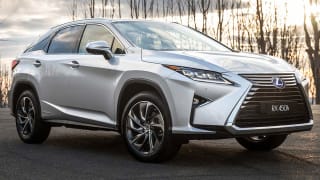
Lexus RX450h 2016 review
Richard Blackburn road tests and reviews the Lexus RX 450h with specs, fuel consumption and verdict.
Browse over 9,000 car reviews
BMW puts the 'e' in mainstream with its first plug-in hybrid — spot the changes.
There are some serious machinations happening beneath the bodywork of the X5 40e, BMW's first plug-in hybrid.
A regular-looking wagon from the outside, the 40e is the Bavarian outfit's acknowledgement that plug-in technology is a smart, short-term solution to electrifying cars.
There's a similarly augmented 3 Series sedan on the way. Both will be sold here in May under the iPerformance moniker to denote their hybrid status.
There's plenty of upside to owning a plug-in BMW if you're an urban commuter.
Not only does the big SUV have an official electric-only range of 31km but also the boost it provides to the 2.0-litre petrol engine propels the 2.2-tonne vehicle to 100km/h from rest in 6.8 seconds.
The downside is the hybrid drivetrain has a multitude of operating modes, all of which affect how it drives and recovers energy and all of which will take time to determine which is best in any given traffic and terrain.
There's little to indicate the X5 40e isn't a conventional car.
In outright terms, buyers will be asked to pay the same money as the premium diesel version, the $118,900 X5 40d, for a hybrid with the performance of the $102,900 X5 30d.
To sweeten the deal, the 40e mirrors the 40d for equipment (how much electricity does a 16-speaker Harman Kardon audio setup use?) and adds adaptive damping with rear air suspension to help counter the extra weight of the motor and battery pack.
The 9kWh lithium-ion battery pack is mounted under the cargo area and trims 40mm from the available depth — the only real compromise, this might affect 5 per cent of potential buyers. At 500L, there's still plenty of room for the golf clubs in the boot.
There's little to indicate the X5 40e isn't a conventional car. That impression is reinforced when under way … until you realise the insulation isn't that good and the car is moving virtually silently.
It'll do this for what BMW says is about 25km of real-world driving. Driven as though the throttle was jagged glass and the driver was barefoot, CarsGuide's companion managed 27km of almost pure electric motoring through the suburbs (the engine kicked in a couple of times on uphill climbs).
The ride on the adaptive suspension is better at soaking up city-speed lumps than in a regular X5 and the combination of factors make this a reasonably attractive urban runabout.
Given that the average daily work commute is 31km, it should be possible to make the trip using less than a litre of petrol; some will make it all the way.
The official fuel use is 3.3L/100km. Long-distance hauls are still the preserve of the diesels in the family and BMW reckons drivers with those intentions will be steered away from the 40e. The hybrid is still a great weekend vehicle and the 2.0-litre engine doesn't struggle with the X5's weight after the battery charge has been depleted.
Eco Pro encourages coasting by shutting down the engine to save fuel
That battery can be fully recharged in about five hours from a regular household power point using the supplied cable (located under the cargo floor where the emergency spare wheel would normally be found).
An "iWallbox Pure" home fast charger halves the recharge time and costs $1750 plus installation.
Operating the 40e is as simple, or complex, as the driver chooses to make it. An "eDrive" switch toggles between running on electric only power, letting the computer determine which motive source is most relevant or fusing the engine to save the battery charge.
All modes mesh with the three "driving experience" settings common to Beemers — Eco Pro, Comfort and Sport — and with the eight-speed auto's shifter once it is flicked across into sport mode.
Eco Pro encourages coasting by shutting down the engine to save fuel and restricting the output of the aircon and seat heaters, while Comfort restores full power to the internal systems and helps regenerate the battery when braking.
Sport delivers maximum regenerative effort. It still isn't as savagely effective as in the i3, which rarely requires use of the brake pedal because the motor is so efficient at retarding speed the second the driver lifts off the accelerator.
Personally, I'd leave the eDrive switch in auto, the driving experience button in Comfort and flick the transmission lever to sport when I want the extra kick.
| Vehicle | Specs | Price* | |
|---|---|---|---|
| X1 Sdrive 18D | 2.0L, Diesel, 8 SP AUTO | $28,490 – 34,320 | 2016 BMW X Models 2016 X1 Sdrive 18D Pricing and Specs |
| X6 M | 4.4L, PULP, 8 SP AUTO | $78,320 – 89,980 | 2016 BMW X Models 2016 X6 M Pricing and Specs |
| X1 Xdrive 20D | 2.0L, Diesel, 8 SP AUTO | $29,370 – 35,420 | 2016 BMW X Models 2016 X1 Xdrive 20D Pricing and Specs |
| X1 Sdrive 20I | 2.0L, PULP, 8 SP AUTO | $29,700 – 35,750 | 2016 BMW X Models 2016 X1 Sdrive 20I Pricing and Specs |
$12,500
Lowest price, based on 236 car listings in the last 6 months